In the beautiful landscapes of Montana, many different native plants grow, each with its own charm and importance. These plants not only add to the state’s natural beauty but also help keep local ecosystems healthy.
In this look at Montana’s native plants, I will show you the amazing flora that makes this rugged and enchanting region special.
- Related article: Guide to Montana State Symbols
Come with me as we explore Montana’s many plants and find out why this state is a paradise for nature lovers.
Top Montana Native Plants
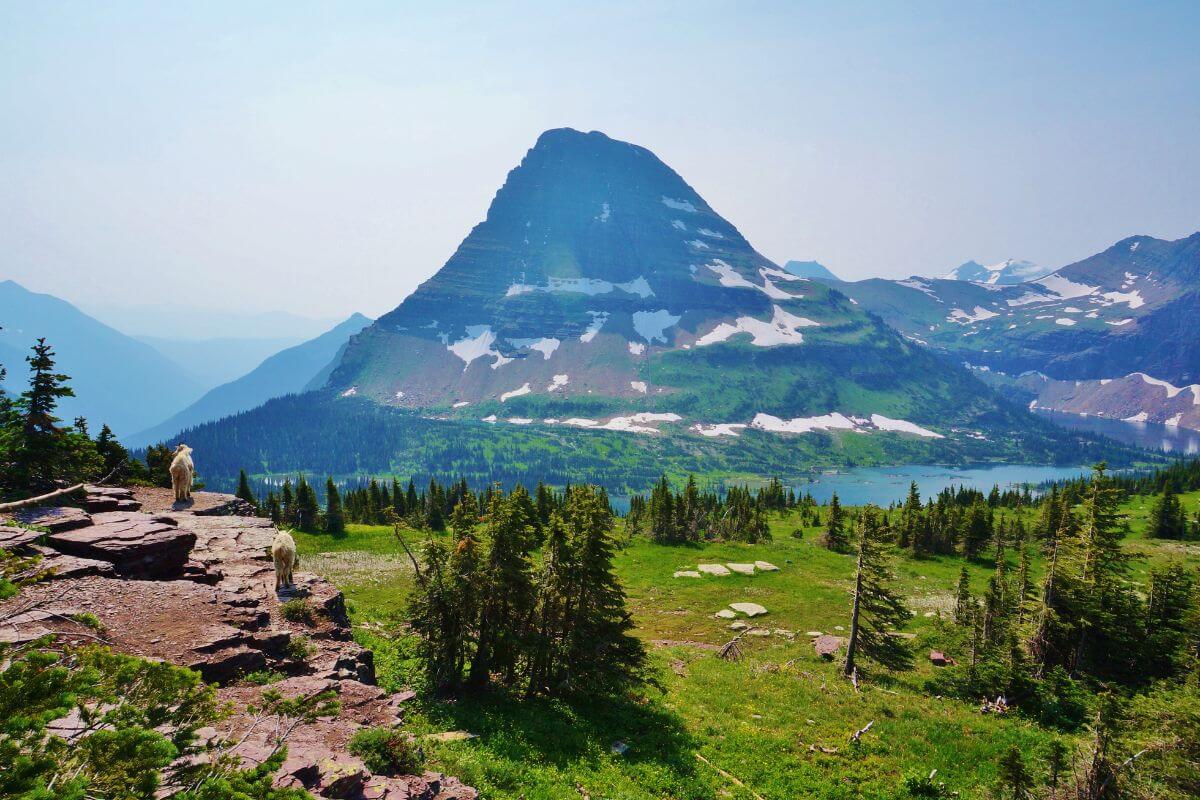
Montana’s natural beauty is a testament to the stunning diversity of its native flora.
Let’s explore the top Montana native plants that thrive in Montana’s wilderness, highlighting their physical features and their ecological significance in the state’s ecosystem.
1. Bitterroot (Lewisia rediviva)
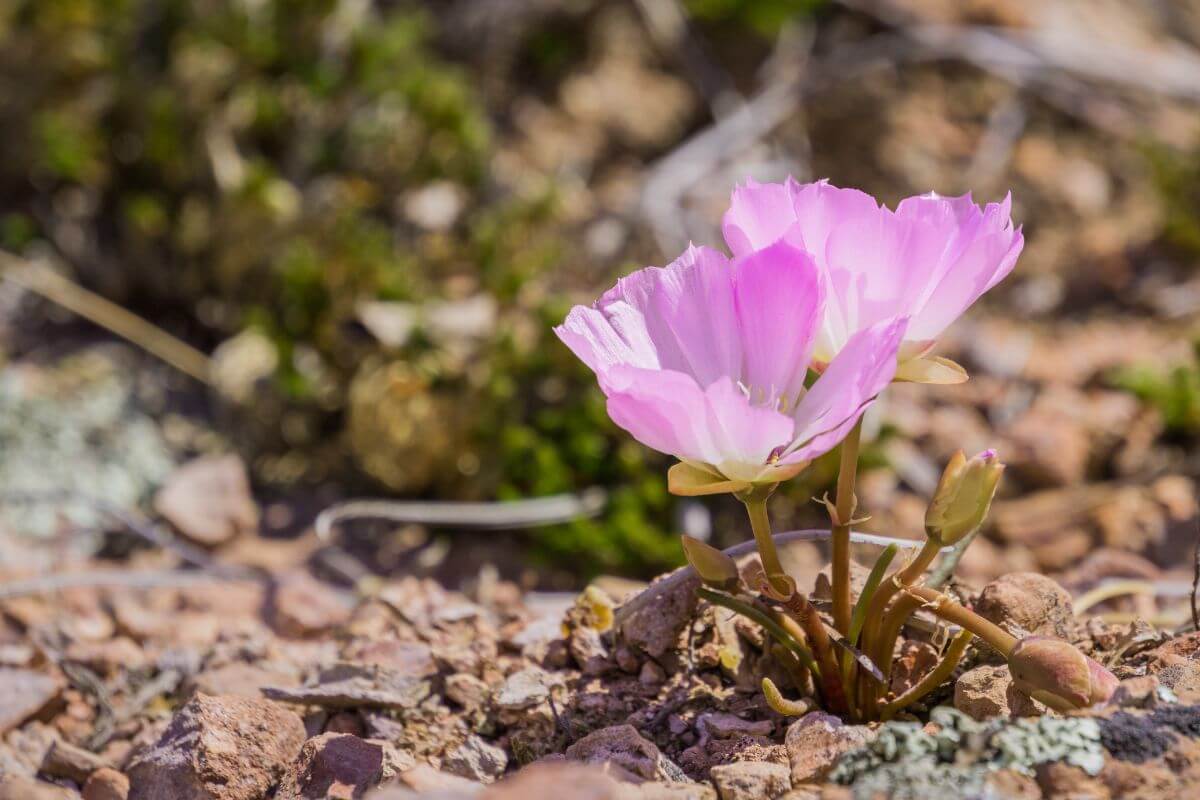
Bitterroot (Lewisia rediviva) is an exceptional plant that holds great significance in the state of Montana, as it proudly stands as Montana’s symbolic state flower.
Belonging to the purslane family, this beautiful herbaceous plant boasts a unique set of features that make it truly remarkable. One of the key traits of the bitterroot is its taproot system, a deep root that enables it to be incredibly drought tolerant.
Through its fleshy taproot, it effectively accesses water and nutrients deep within the soil, eliminating the need for additional watering.This adaptation allows the bitterroot to thrive even in Montana’s dry summers.
You can often find this impressive plant flourishing in mid-elevation habitats, typically ranging between 2,000 to 10,000 feet. It is perfectly adapted to the environmental conditions and soil found in these areas. You can often see bitterroot growing on rocky areas and hillsides, making the scenery even more stunning.
Bitterroot is also known for its captivating flowers. Its showy white and pink fragrant flowers add a touch of elegance to the landscape. These flowers, measure about 1-2 inches in diameter and consist of five delicate and distinct petals.
2. Ponderosa Pine (Pinus ponderosa)
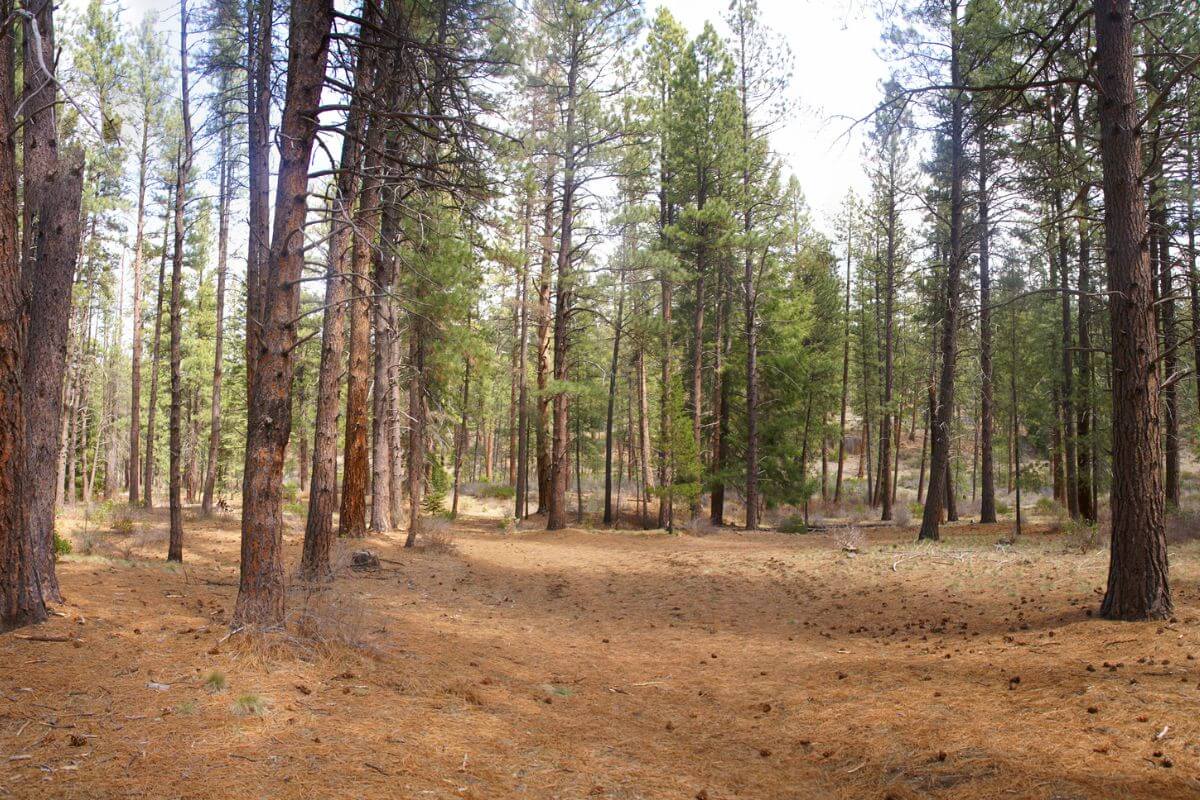
The Ponderosa pine is the symbolic tree of Montana, it is an evergreen conifer tree, standing at heights of 60-130 feet.
The Ponderosa pine is a big, important tree with many special features. Its trunk is 30-60 inches wide, and it has a wide, open top that looks beautiful against the sky.
The tree’s bark is thick and deeply grooved, with a rich reddish-brown color that shows its age. The green needles, growing in clusters of three and 5-10 inches long, stay bright all year, adding to the tree’s beauty.
The Ponderosa pine can live in many places, like dry mountain slopes and mesas, and it can handle different soils and climates. Besides looking nice, it provides homes for wildlife and wood for various uses.
This tree grows slowly but can live for hundreds of years. It does best in USDA hardiness zones 3-7, preferring well-drained soil and full sun.
However, it has some problems. Pests like bark beetles and dwarf mistletoe can harm it, and since it can catch fire easily, it can help wildfires spread.
The Ponderosa pine is an important tree known for its big size and beautiful look, making it a valuable part of our natural landscapes.
3. Beargrass (Xerophyllum tenax)
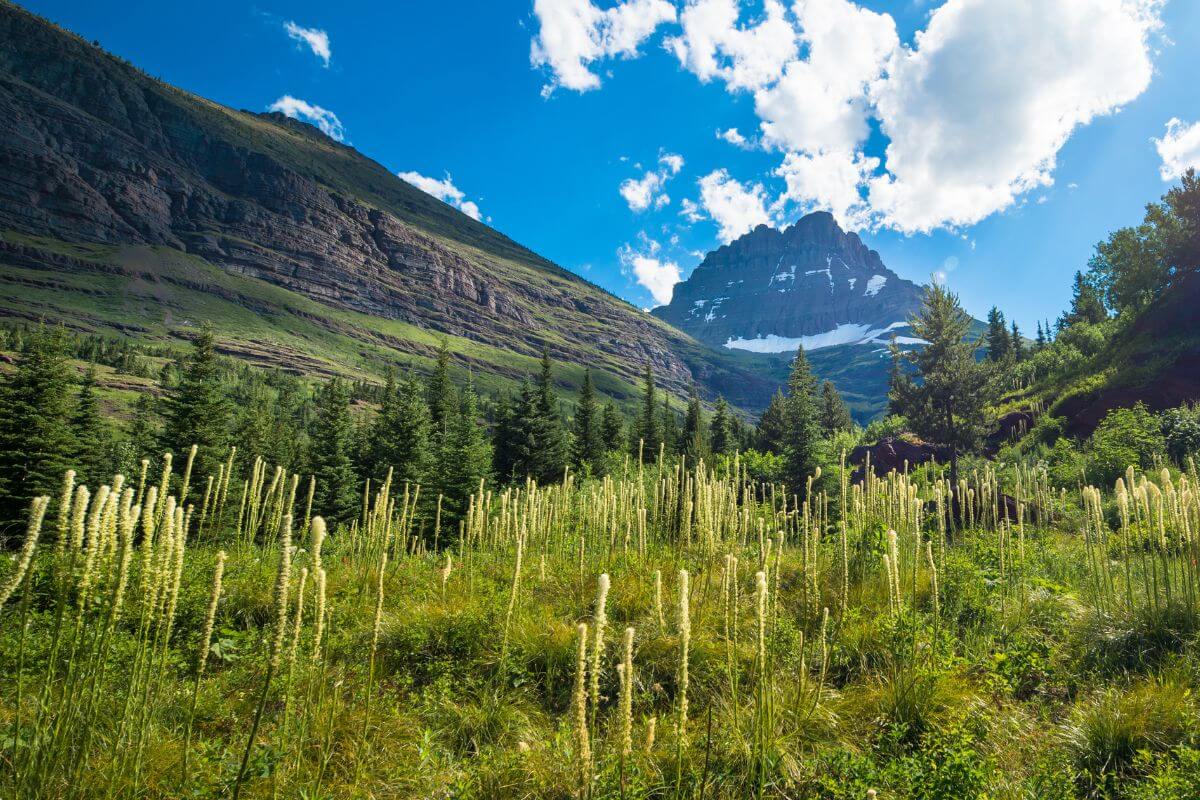
Beargrass (Xerophyllum tenax) is a plant native to Montana, found in subalpine meadows and open forests. It has long, narrow leaves that grow in clumps or at the base of the plant.
The most striking feature of beargrass is its tall flower stalks, which can reach up to 6 feet. These stalks are topped with clusters of small, dense white flowers.
Beargrass thrives in the subalpine meadows and open forests of Montana and western North America, well-suited to the local climate and soil.
Besides its beauty, beargrass is important for the environment. It provides food for animals like bears, deer, and elk.
Beargrass grows slowly, taking 5-7 years to flower, but the wait is worth it. It can grow in USDA hardiness zones 4-8 and prefers well-drained soil and full sun.
Native American tribes have used beargrass for centuries in basket weaving and as a medicine. It has been valued for both practical and spiritual purposes.
4. Yarrow (Achillea millefolium)

Yarrow (Achillea millefolium) is a native Montana plant that stands out with its long-lasting, beautiful flowers.
Yarrow grows up to 3 feet tall with few branches except near the top. Its leaves are 3-5 inches long, with many small leaflets, giving them a delicate, fern-like look.
The clusters of small white flowers at the top of the stems are the main attraction. Each cluster has many small, yellowish-white flowers, sometimes pink.
Yarrow belongs to the Asteraceae (daisy) family and is a hardy perennial. It grows well in USDA hardiness zones 3-9, preferring well-drained soil and full sun. This makes it easy to care for in gardens.
Yarrow is not just pretty; it is important for the environment. It attracts many pollinators like butterflies, bees, and other insects. It’s a great addition to gardens, flower beds, or containers. It also helps improve water quality and provides a habitat for wildlife.
Yarrow has a long history of medicinal use, treating ailments like colds, fever, and headaches. It has even been used in brewing beer. However, be careful as Yarrow can be toxic to some animals like horses and cattle, and it can cause skin irritation in some people.
5. Saskatoon Berry (Amelanchier alnifolia)
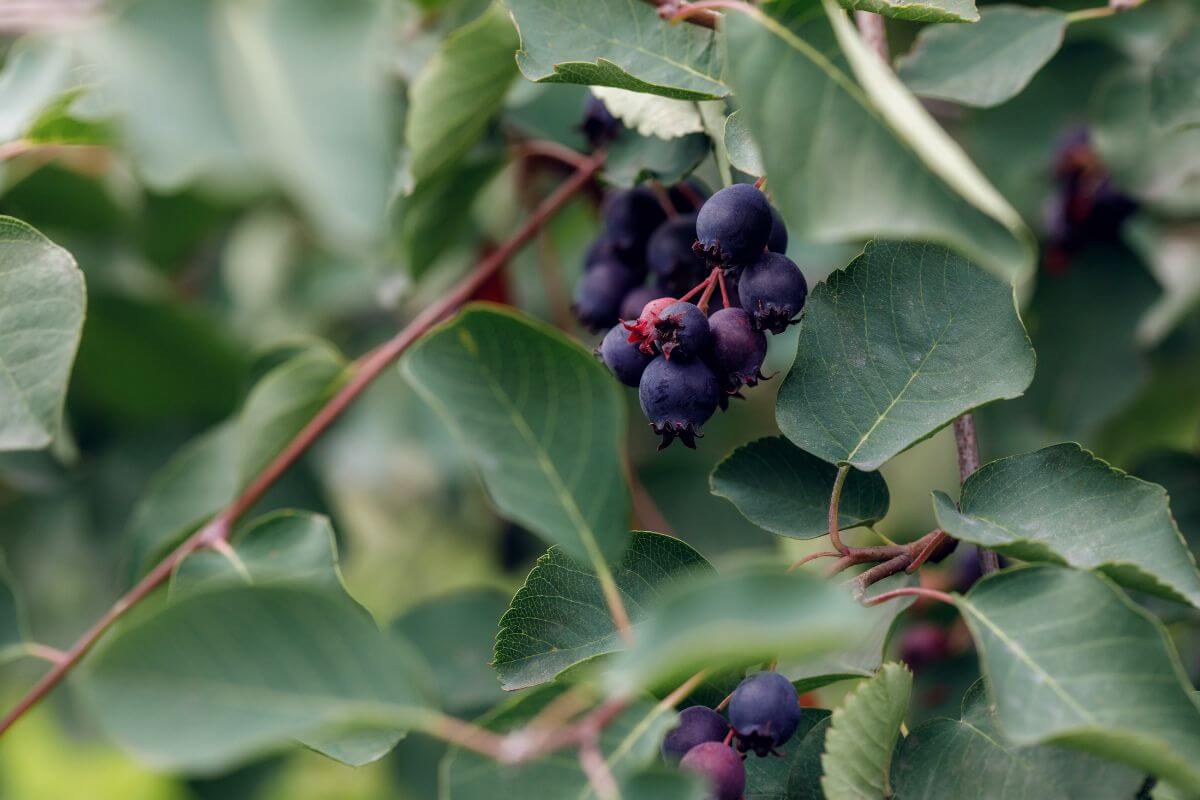
Saskatoon berry is a deciduous shrub standing up to 18 feet tall, adorned with clusters of small, delectable berries that rival, if not surpass, the deliciousness of blueberries.
However, it’s not just humans who savor these berries. Wildlife, including birds and bears, rely on them as a vital food source. The Saskatoon berry’s flavors are simply irresistible.
This remarkable plant also serves as a natural filtration system, improving the quality of water and providing a sanctuary for various wildlife species.
Growing and caring for Saskatoon berries is a breeze. This low-maintenance plant thrives in well-drained soil and loves basking in full sun.
It’s hardy in USDA hardiness zones 2-7, making it accessible for a wide range of gardeners. Plant this deciduous shrub in borders and woodland gardens.
But the uses of Saskatoon berry don’t end with its delectable fruit. From scrumptious jams and jellies to mouthwatering pies, it’s a culinary superstar. It even finds its way into beer brewing, showcasing its versatility in both the garden and the kitchen.
While Saskatoon berry is generally safe for human consumption, the seeds and leaves contain trace amounts of cyanide that can be toxic in large quantities. As with all things in life, moderation is key.
6. Rocky Mountain Iris (Iris missouriensis)
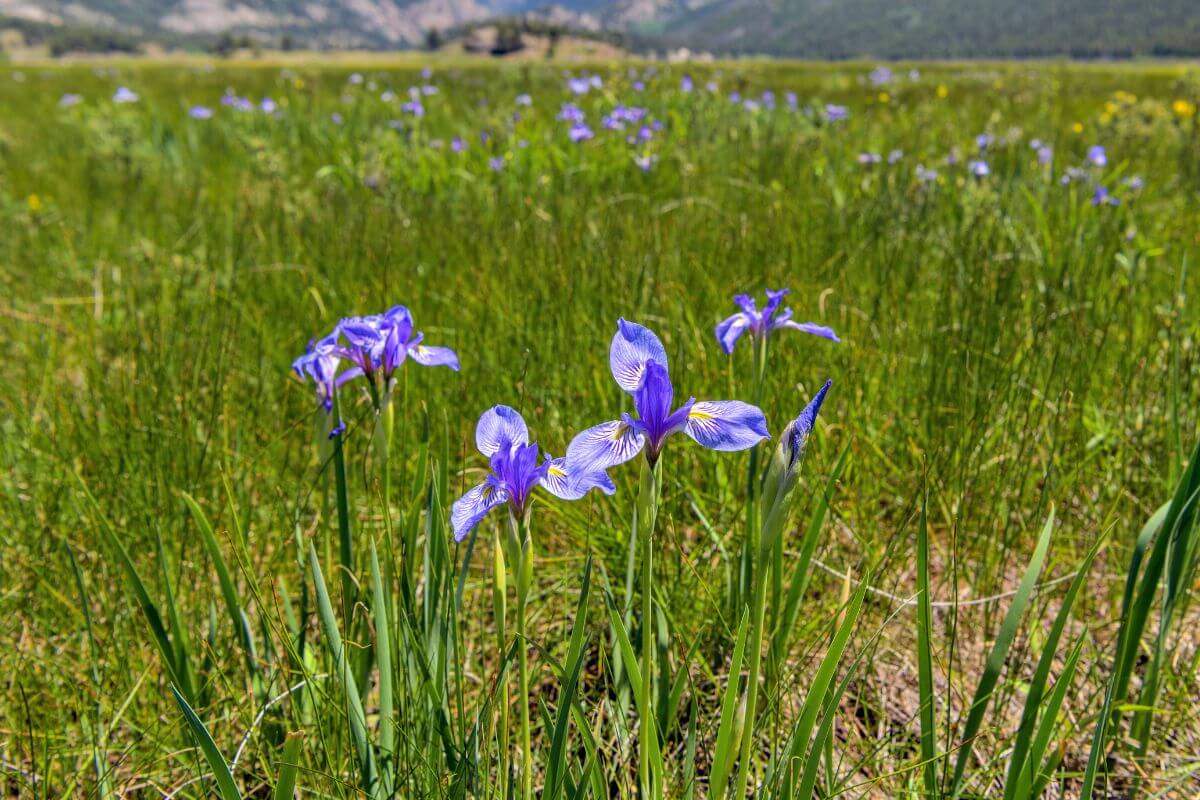
The Rocky Mountain iris, or Iris missouriensis, graces the Montana landscape with its remarkable beauty and adaptability. This native plant stands tall at 1-2 feet, commanding attention with its slender stems and striking grayish-green leaves.
However, it’s the large, pink blooms that steal the show, adorning meadows, stream banks, and wetlands from late spring to summer. What sets the Rocky Mountain iris apart is its ability to thrive in various habitats, from wetlands to meadows.
This hardy perennial, spreading through rhizomes, not only survives but flourishes in Montana’s ever-changing climate and soil conditions, ensuring its enduring presence.
But the Rocky Mountain iris is more than just a pretty face. It plays a pivotal role in Montana’s ecosystem, providing food and shelter for local wildlife, while also contributing to soil health.
The best part is that growing and caring for the Rocky Mountain iris is a breeze. This low-maintenance plant thrives in wet soil and revels in the warmth of the sun.
In the fall, you can propagate it by dividing the rhizomes, ensuring more of its exquisite presence in your garden.
7. Lewis Flax (Linum lewisii)
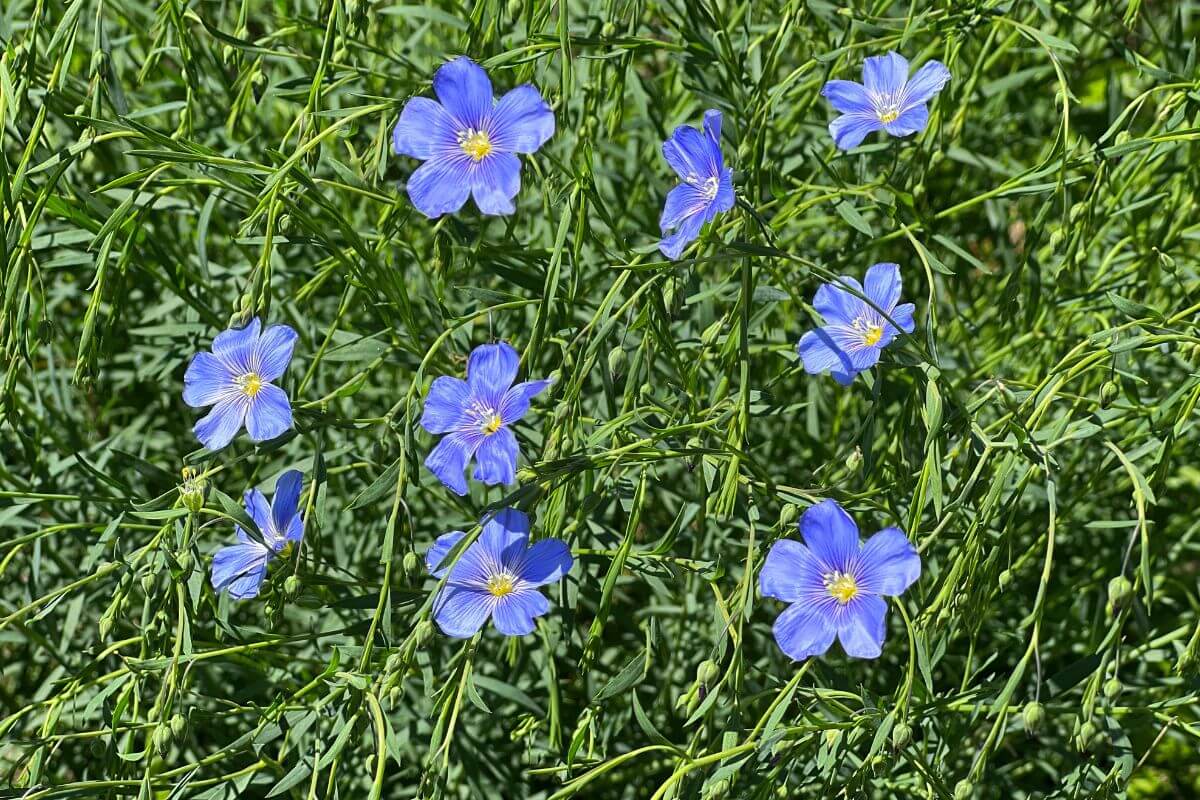
Lewis flax (Linum lewisii), a native Montana plant, is a captivating addition to any garden, sure to make a statement.
Its vibrant blue flowers and slender leaves set it apart as a perennial herbaceous beauty.
Growing up to 2-3 feet tall and 1 foot wide, its narrow blue-green leaves are gracefully arranged in a spiral pattern, enhancing its elegant appearance. Lewis flax thrives in well-drained soil and revels in full sunlight, though it can tolerate some shade.
What truly stands out about this plant is its ability to withstand Montana’s harsh winters and prolonged droughts, making it a low-maintenance garden choice that doesn’t demand extra watering.
Adding Lewis flax to your garden isn’t just for aesthetics; it plays a vital role in supporting local wildlife and maintaining soil health.
This plant serves as a valuable source of food and habitat for various animals, contributing to the local ecosystem. Lewis flax also carries cultural significance in Montana, representing the resilience and rugged beauty of the state’s natural environment.
Thanks to its adaptability and hardiness, Lewis flax thrives in Montana’s diverse ecosystems. It is an annual or short-lived perennial. This semi-evergreen plant with its semi-woody base will undoubtedly bring beauty to your garden.
8. Serviceberry (Amelanchier spp.)
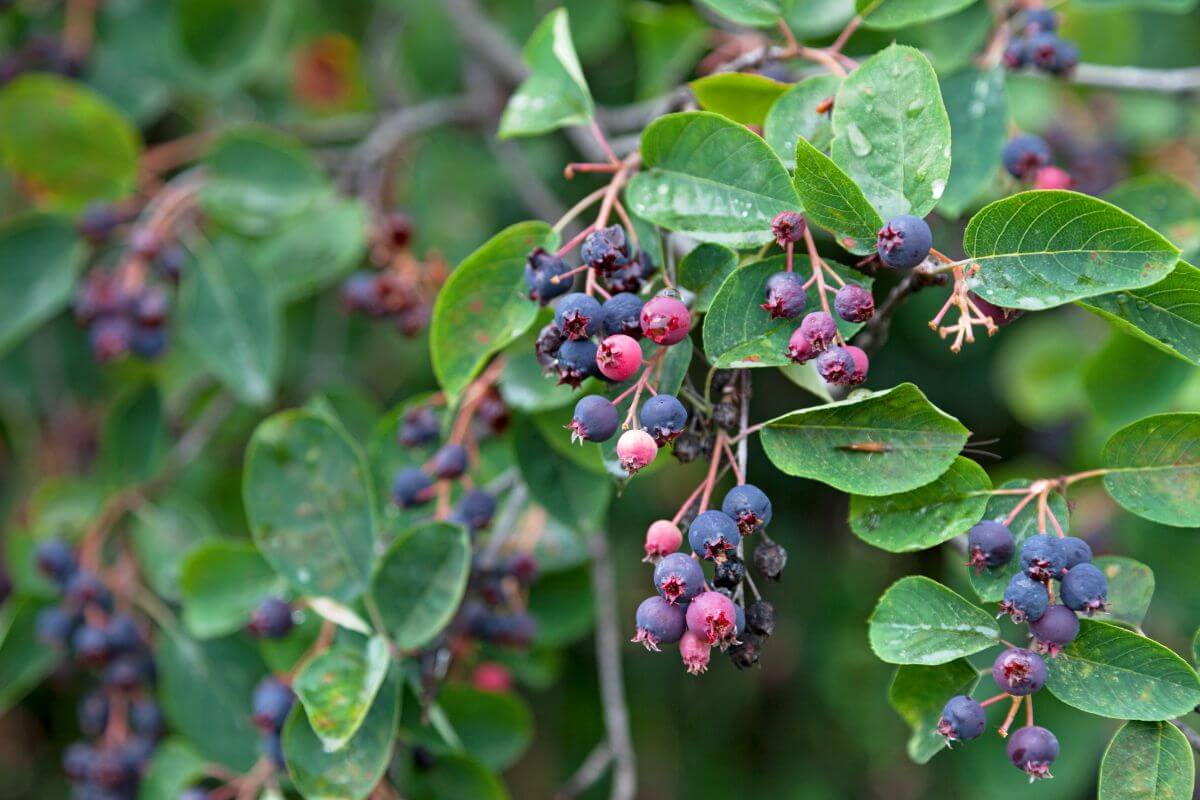
Serviceberry (Amelanchier spp.) is a diverse section of plants, consisting of various species of deciduous shrubs or small trees. They are typically small trees or large shrubs, growing to around 10-15 feet tall, although they can occasionally reach greater heights. With their rounded crowns and potential for forming root suckers, they can also be cultivated as shrubs.
These plants are suitable for various regions throughout the United States and Canada. In fact, every state, except for Hawaii, boasts a native species of serviceberry.
One of the most noteworthy aspects of serviceberries is their ecological importance. They serve as vital food sources for wildlife, including birds and various mammals.
They also act as important host plants, supporting the caterpillars of numerous butterfly and moth species. Two notable species within this group are Amelanchier alnifolia and Amelanchier utahensis.
Here are some of the key details for each species:
| Species | Growth Characteristics | Sunlight & Soil Preferences | Flower Color | Fruit Color | USDA Hardiness Zones |
|---|---|---|---|---|---|
| Amelanchier alnifolia | Multitrunked shrub or small tree, up to 15 feet tall | Full sun, well-drained soil | White Flowers | Blue-black | Zones 2-9 |
| Amelanchier utahensis | Much-branched deciduous shrub or small tree, 3-15 ft | Full sun, well-drained soil | White Flowers | Red-purple | Zones 4-8 |
With their stunning aesthetic appeal and significant ecological contributions, serviceberries are a remarkable choice for any garden. Their ability to attract wildlife and provide a habitat for various species of butterflies and moths further enhances their desirability.
9. Western Columbine (Aquilegia formosa)
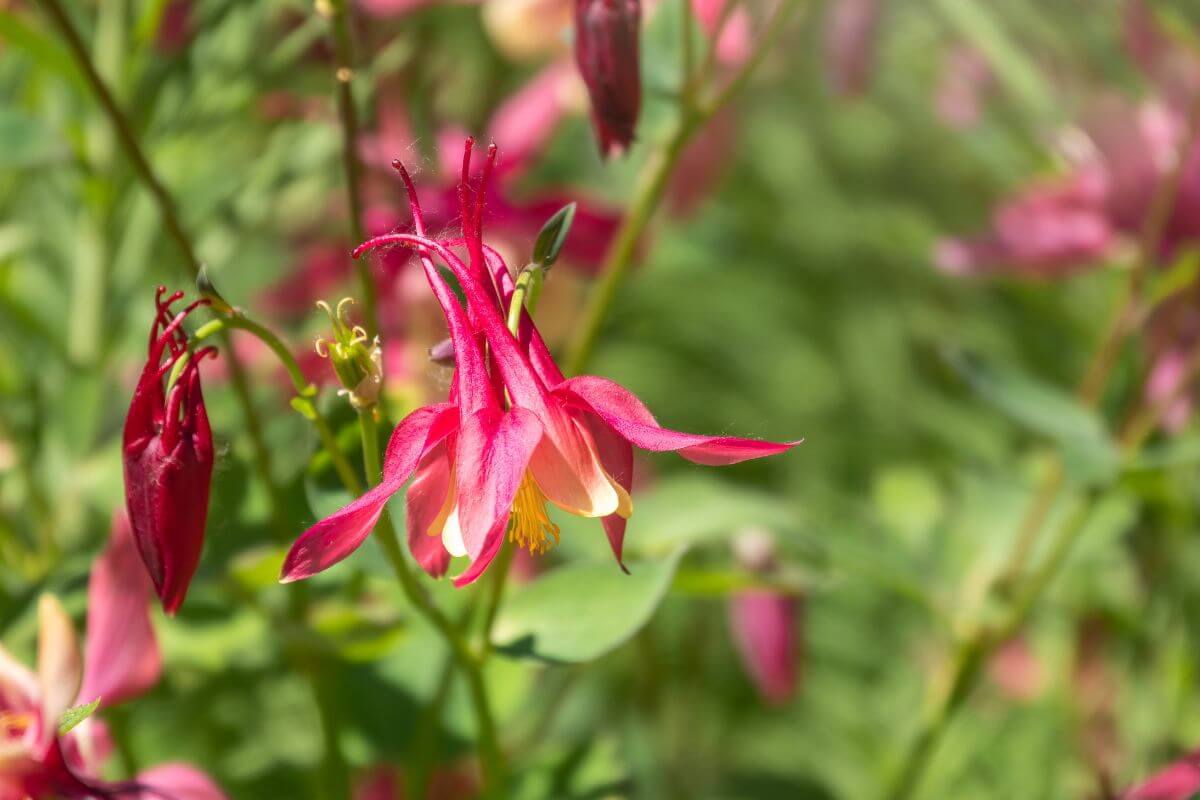
The Western columbine (Aquilegia formosa) is a Montana native plant with striking beauty. Its tuberous flowers droop gracefully, featuring pale peach with yellow accents, and they attract hummingbirds and butterflies, making it a spectacle of nature.
This perennial herb grows in clumps up to 3 feet tall and thrives in moist soil, commonly found in meadows, open forests, stream banks, and rocky slopes across Montana.
The Western columbine is hardy in USDA hardiness zone 3 and can grow in full sun or partial shade, making it adaptable to different garden conditions.
It prefers moist soil but can withstand some drought, so ensure the soil doesn’t dry out completely. The Western columbine is generally safe for human consumption, its seeds and leaves contain small amounts of cyanide, which are typically not harmful but should not be consumed in large quantities.
The Western columbine is a great choice to add elegance and allure to your garden, with its enchanting flowers and adaptability to various growing conditions.
10. Beardtongue (Penstemon)
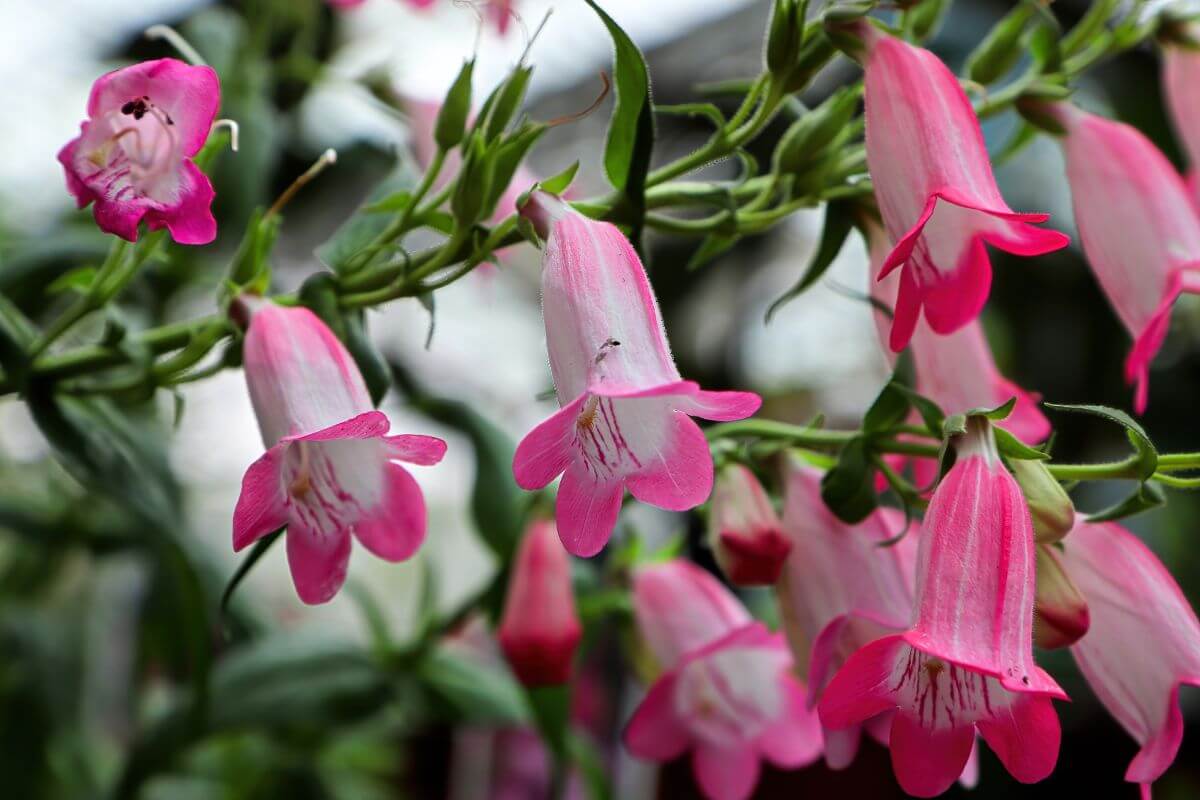
Beardtongue, also known as Penstemon, is a low-maintenance, long-blooming, colorful, herbaceous wildflower
There are several common varieties of beardtongue found in Montana, each with its own unique characteristics:
- Large Flowered Beardtongue – This is a stout perennial herb with 1-2 erect stems that are 5-10 cm tall and arising from a taproot surmounted by a woody, usually.
- Payette Beardtongue – The leaves of Beardtongue can be up to 6 inches long and are most often more or less elliptical in shape and hairless.
- Pineneedle Beardtongue –This is a low-growing, evergreen perennial with needle-like leaves and bright red flowers. It can grow up to 1 foot tall and prefers well-drained soils.
- Davidson’s Beardtongue – This is a diminutive native that has tiny, round leathery evergreen leaves topped with blue to purple flowers in summer and is found in rocky outcroppings in the Coast Range, Cascade, and Steens mountains.
Beardtongue is a versatile plant that can be utilized in rock gardens, troughs, or other containers. It thrives in full sun and requires sharp drainage to showcase its stunning tubular flowers.
From shades of white to pinks, blues, lavender, and purple, this plant offers a rainbow of colors, ensuring a long-lasting and captivating display.
11. Big Sagebrush (Artemisia tridentata)
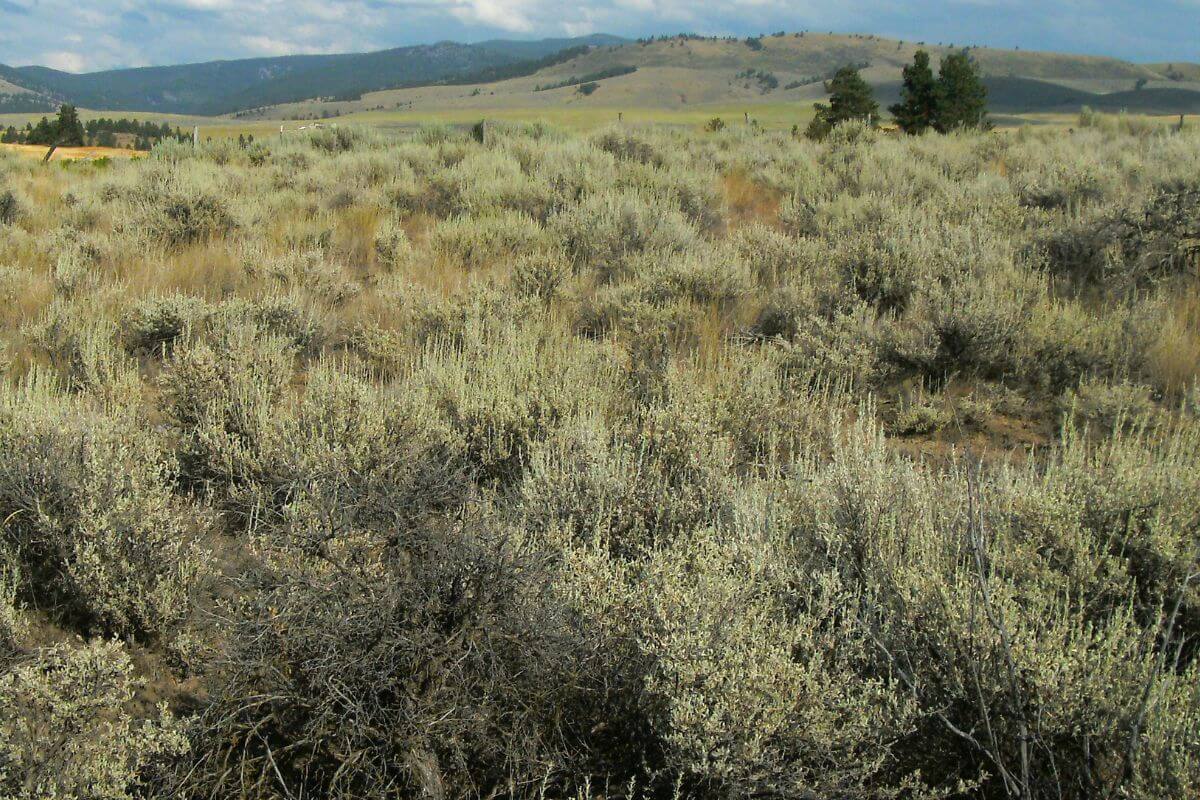
The Big sagebrush (Artemisia tridentata) is a captivating native plant in Montana, known for its beauty and resilience.
This woody perennial, part of the sunflower family, adds vibrancy to the landscape with its round shape, short trunk, and stout branches.
Its ability to adapt and thrive in harsh environments is a testament to its resilience, and it remains evergreen throughout the year.
Beyond its aesthetic appeal, the Big sagebrush plays a crucial role in providing essential food and nesting habitat for various wildlife species, including elk, jackrabbits, birds, and small mammals.
The sagebrush ecosystem in Montana is dynamic and multi-use, accommodating activities such as livestock grazing, oil and gas development, mineral extraction, and recreation.
These activities not only bring joy to people but also contribute to local economies. One of the most remarkable qualities of the Big sagebrush is its ability to thrive in drought conditions and tolerate well-drained soils.
This makes it an excellent choice for xeriscaping, a landscaping technique that reduces the need for supplemental water. The Big sagebrush assists in water filtration, reducing soil erosion and improving water infiltration.
Big sagebrush grows in valleys and basins and on plains, plateaus, and mountain slopes nearly everywhere except for a swath of central Montana north of U.S. Highway 2 and in the state’s far northwestern corner.
12. Blanketflower (Gaillardia aristata)
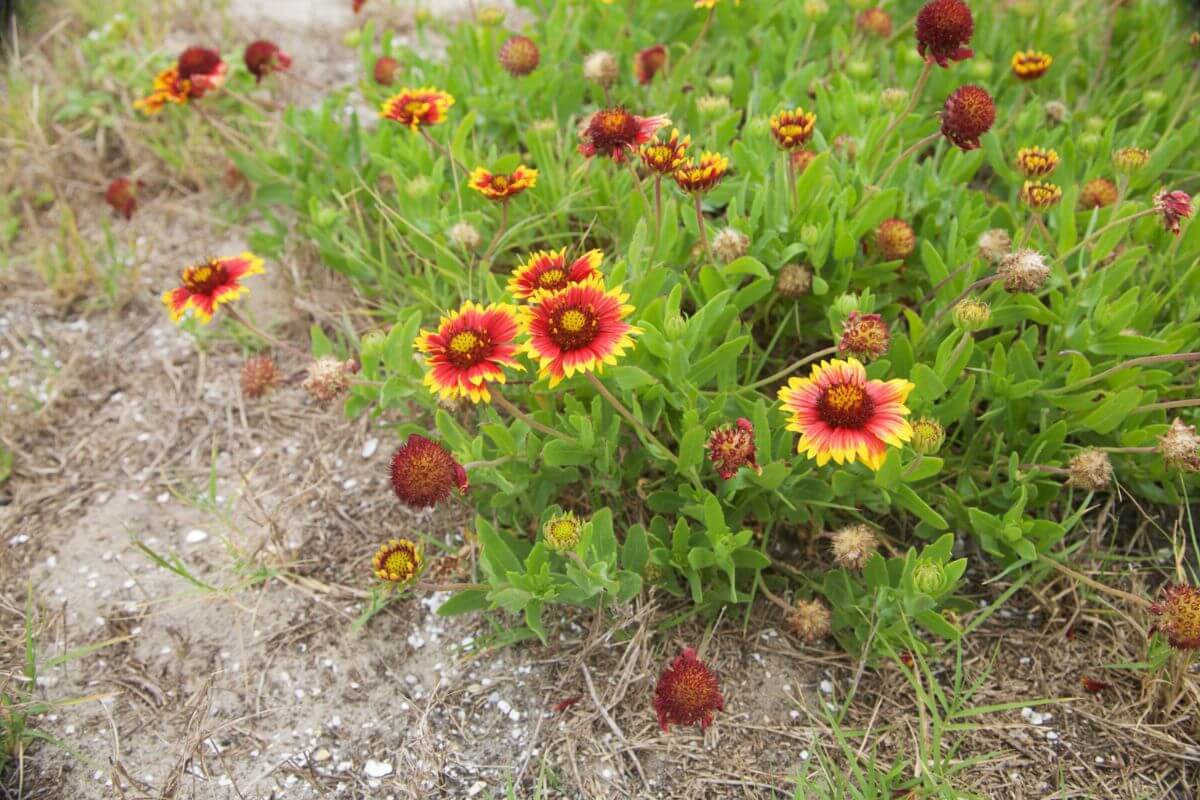
Blanketflower, scientifically known as Gaillardia aristata, is a captivating native plant known for its quick growth, hairy stems, and striking yellow blooms with orange-brown centers.
This drought-tolerant perennial thrives in full sun and well-drained soil, making it a versatile addition to various garden settings, including borders, rock gardens, small spaces, and containers.
One of the blanketflower’s remarkable features is its attractiveness to butterflies, making it an excellent choice for those looking to create a butterfly-friendly garden.
Blanketflower is a flowering plant in the sunflower family that grows 1 to 3 feet tall with showy daisy-like 3″- 4″ flowers that bloom from May through September.
Its long lifespan makes it a dependable choice for any garden, adding both color and ornamental value. This clumping plant also serves a practical purpose beyond their beauty by providing cover and a valuable food source for pollinators, wildlife, and even livestock.
13. Buffaloberry (Shepherdia)
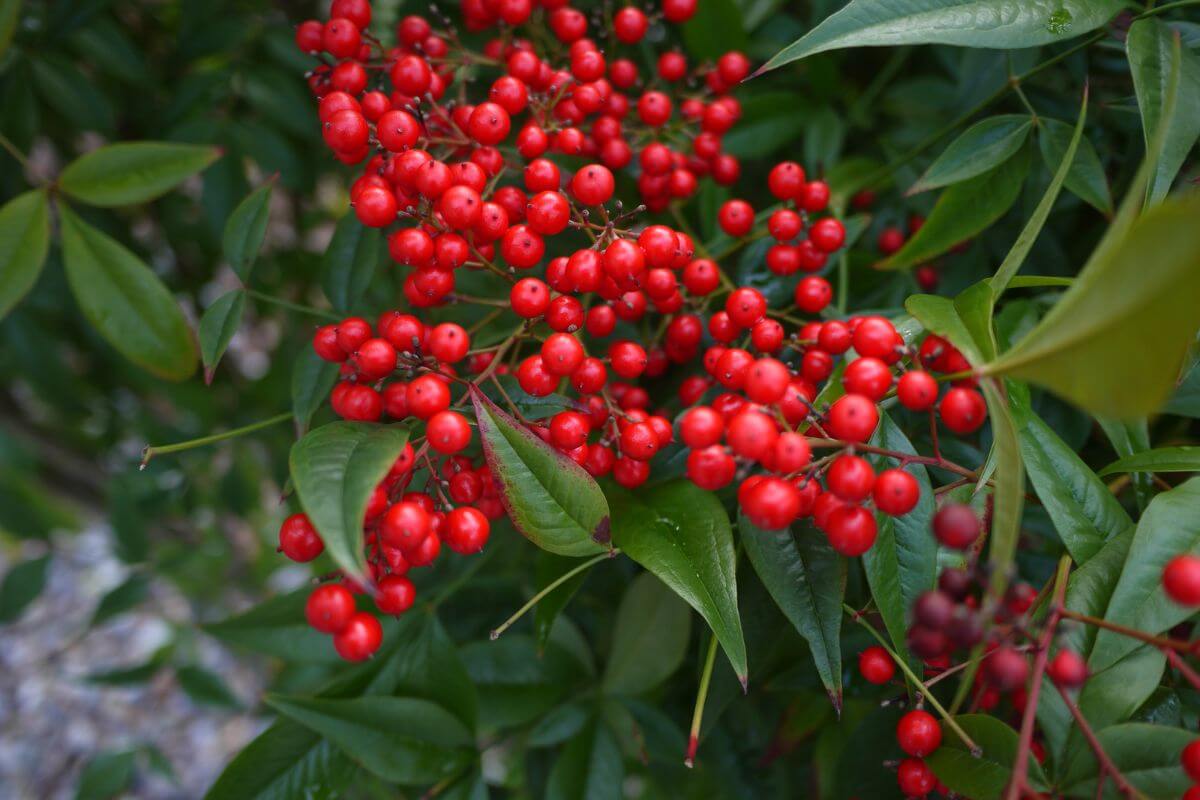
Buffaloberry, also known as Shepherdia, is a medium-sized, deciduous shrub that should find a place in every landscape.
Its most notable feature is the edible berries it produces, which are small, bright red, and have a pleasantly tart taste that sweetens after a frost.
Buffaloberry can reach heights of 6 to 20 feet tall and takes on a mound-shaped form, sometimes resembling a tree. Its vibrant red berries not only add visual interest to the landscape but also serve as a valuable food source for various wildlife, including numerous bird species.
What makes buffaloberry unique is its ability to thrive in a wide range of soil types and challenging growing conditions.
This mounded shrub is known for its hardiness, making it suitable for poor soils and even extreme climates. Cultivate this easy-to-maintain shrub as part of xeriscaping, within shrub borders, or as a standout specimen plant.
It’s widely distributed across the Pacific Northwest and Canada and can be found growing as an understory plant in conifer and pine forests.
Buffaloberry is not only valuable in its natural habitat but also in landscaping. It can be used in various ways, making it a versatile choice for gardeners.
14. Chokecherry (Prunus virginiana)
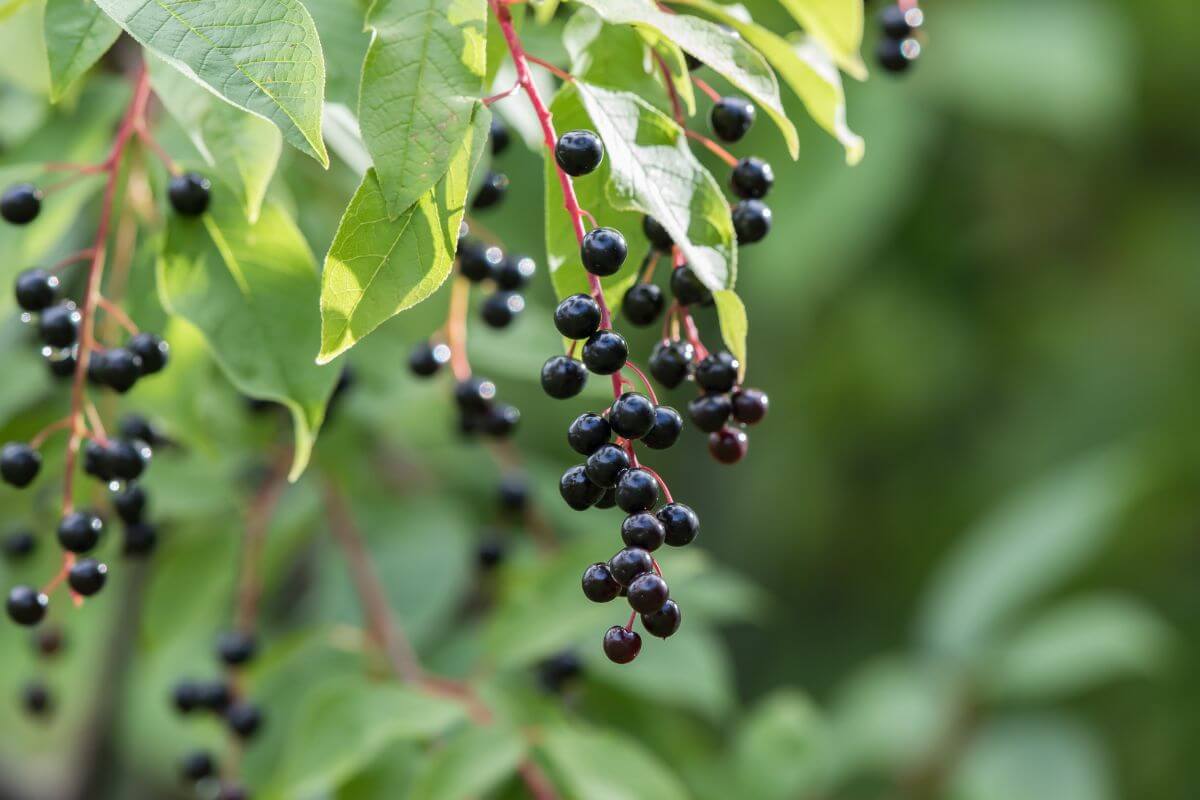
Chokecherry, scientifically known as Prunus virginiana, is a formidable native plant that thrives in the wild landscapes of Montana and southern Canada.
This large deciduous shrub or small tree, reaching heights of 20 to 30 feet tall, captivates with its elegant white flower clusters and later reveals vibrant red fruits that are beloved by wildlife.
What truly distinguishes chokecherry is its exceptional adaptability. It can flourish in a wide range of soil conditions, making it a reliable choice for gardeners across USDA hardiness zones 2-7.
This versatile plant can serve multiple roles in your landscape. It can provide shelter have a high shade tolerance or add depth as an understory tree.
Chokecherry’s robust root system also makes it an excellent option for erosion control, helping stabilize banks and slopes.
If you’re looking for a natural privacy fence, this resilient plant can be pruned and shaped to suit your needs. With its adaptability and versatility, chokecherry is a valuable addition to any garden or landscape.
15. Clover (Dalea)
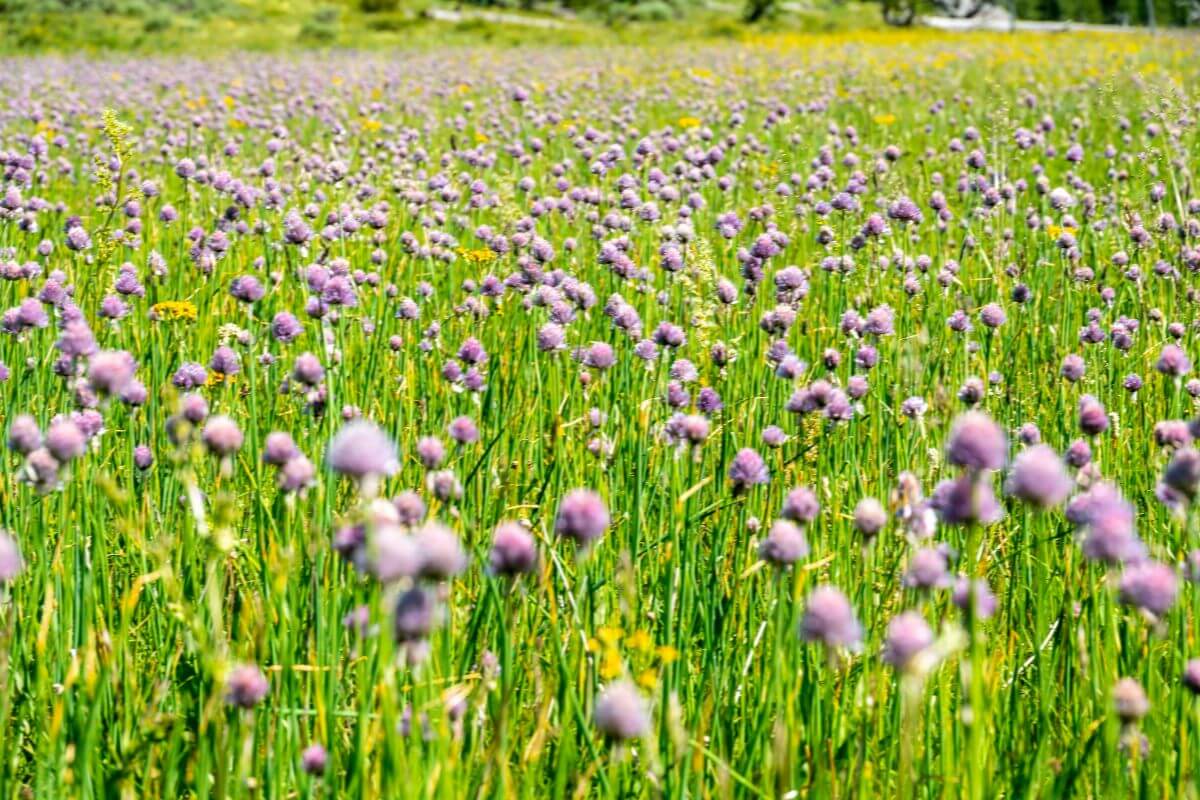
Clover, specifically the Dalea variety, is a group of flowering perennial plants that grace the open fields, grasslands, and plains of central and western Montana.
These charming plants are characterized by their trifoliate leaves, typically sporting three leaflets, though some species may have 5 or 7.
With smooth stems and dainty blooms in vibrant shades of red, purple, white, or yellow, clover adds an elegant touch to any landscape.
White clover, a standout in this group, can thrive for three to five years and reaches a modest height of 20 to 30 cm (8 to 12 inches).
Its showy blossoms emerge among delicate foliage, making it an ideal choice for pollinator gardens, rock gardens, or naturalized landscapes.
The versatility of clover is remarkable as it adapts effortlessly to various soil types and conditions, making it a valuable addition to any garden.
Clovers can find their place whether in the sun’s golden rays or the cool embrace of shade. Some species, while content in dry soils, can also thrive in water-logged sites.
Two popular Montana clovers include:
- Purple Prairie Clover (Dalea purpurea) – This low-maintenance wildflower prospers in full sunlight. It has a deep taproot and is drought tolerant, producing vibrant magenta flowers.
- White Prairie Clover (Dalea candida) – Similar to its relative, purple prairie clover, this perennial possesses a taproot. It produces small white flowers around a dense cone atop bright stems.
This makes clover highly coveted by livestock, as it pleases their taste buds and provides a substantial amount of protein, phosphorus, and calcium in both its green and dry stages.
16. Juniper (Juniperus)
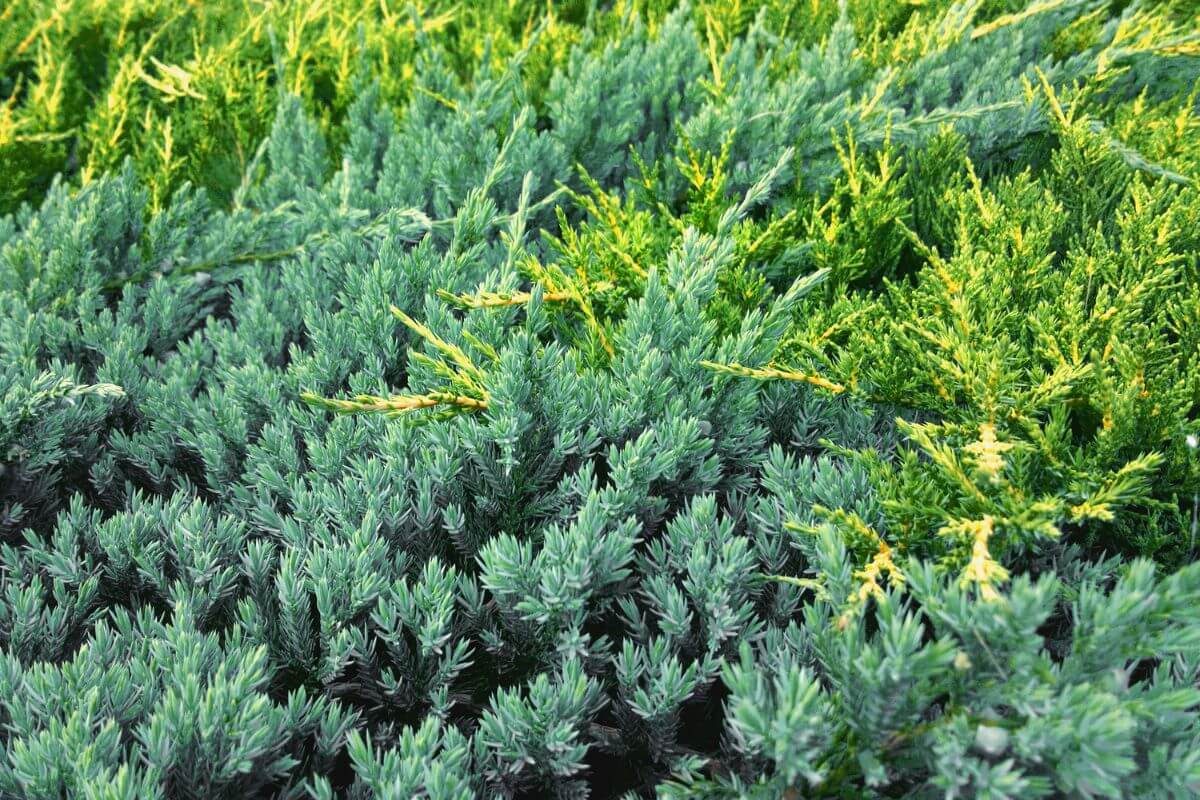
Juniper is a versatile evergreen shrub or tree cherished in gardens. Its appealing foliage, low-maintenance nature, and practical uses make it popular.
Juniper has white flower clusters that transform into vibrant red fruits, adding elegance.
What sets juniper apart is its adaptability to various soil conditions, thriving in USDA hardiness zones 2-9. They thrive on inclines and hillsides, serving as both ground cover and border plants.
But its usefulness doesn’t end there. Plant junipers to make it a shaded landscape element, an understory tree, an erosion control measure, or even a living privacy fence.
The juniper trees add character and functionality to any outdoor space, offering both beauty and practicality. It’s beauty lies in its ability to thrive in various environments, adapt to soil conditions, and offer practicality in landscape design.
17. Michaux’s Wormwood (Artemisia michauxiana)
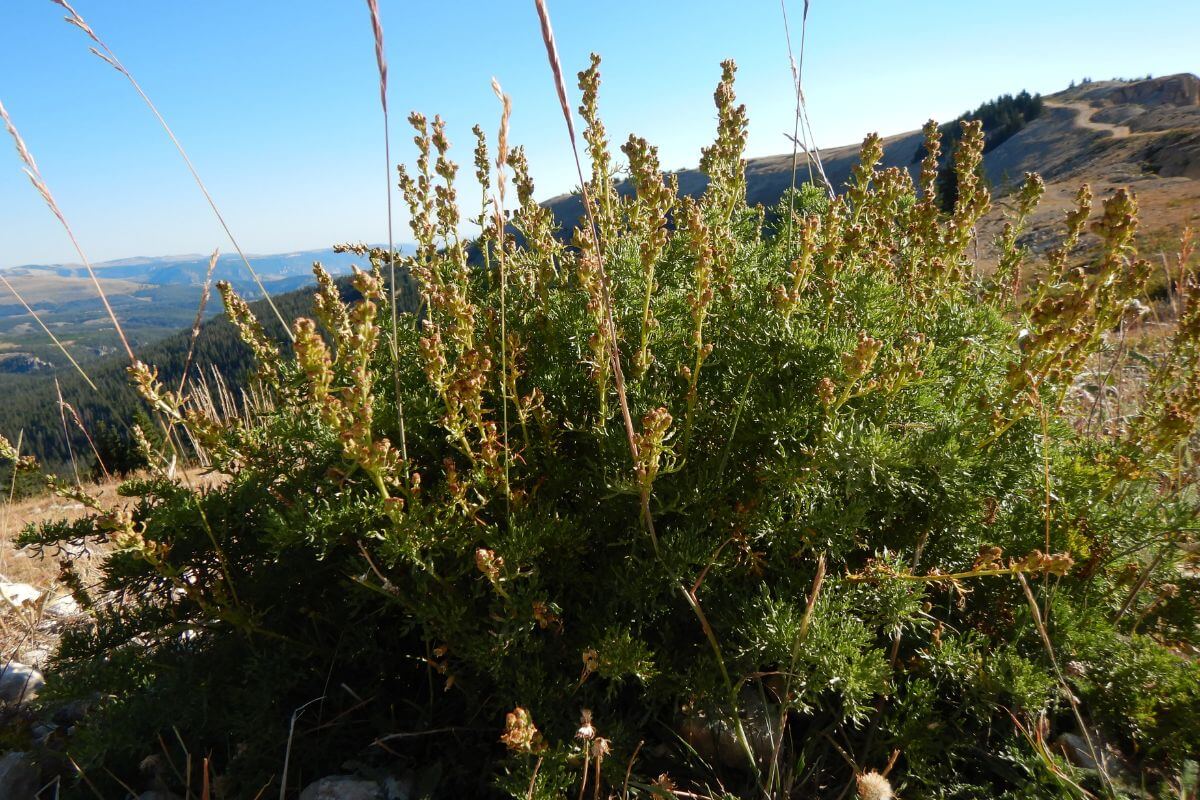
Michaux’s wormwood, also known as Artemisia michauxiana, is another sunflower relative and member of the aster family native to Montana.
With its vibrant green foliage and delicate lemon scent, this rhizomatous perennial plant adds a touch of elegance to any garden or landscape.
Growing up to 15 inches tall and spreading up to 3 feet across, Michaux’s wormwood forms a mounding growth habit, creating a dense and attractive mound of foliage.
The leaves of Michaux’s wormwood are a standout feature, with narrow segments that give them a delicate and intricate appearance.
These leaves are typically hairless or lightly hairy and bear yellowish resin glands, which add a subtle touch of beauty to the plant.
Ideal for pollinator gardens, rock gardens, or naturalized landscapes, Michaux’s wormwood is a versatile plant that can thrive in a variety of settings.
It is well-suited to USDA hardiness zones 4-8 and prefers full sun and well-drained soil. This hardy plant is also drought-tolerant, making it a perfect choice for those with dry summers or who live in areas with limited water resources.
It’s important to note that Michaux’s wormwood contains thujone, a compound that can be toxic in large amounts. As with any plant, it’s crucial to be aware of its potential effects.
18. Redosier Dogwood (Cornus sericea)
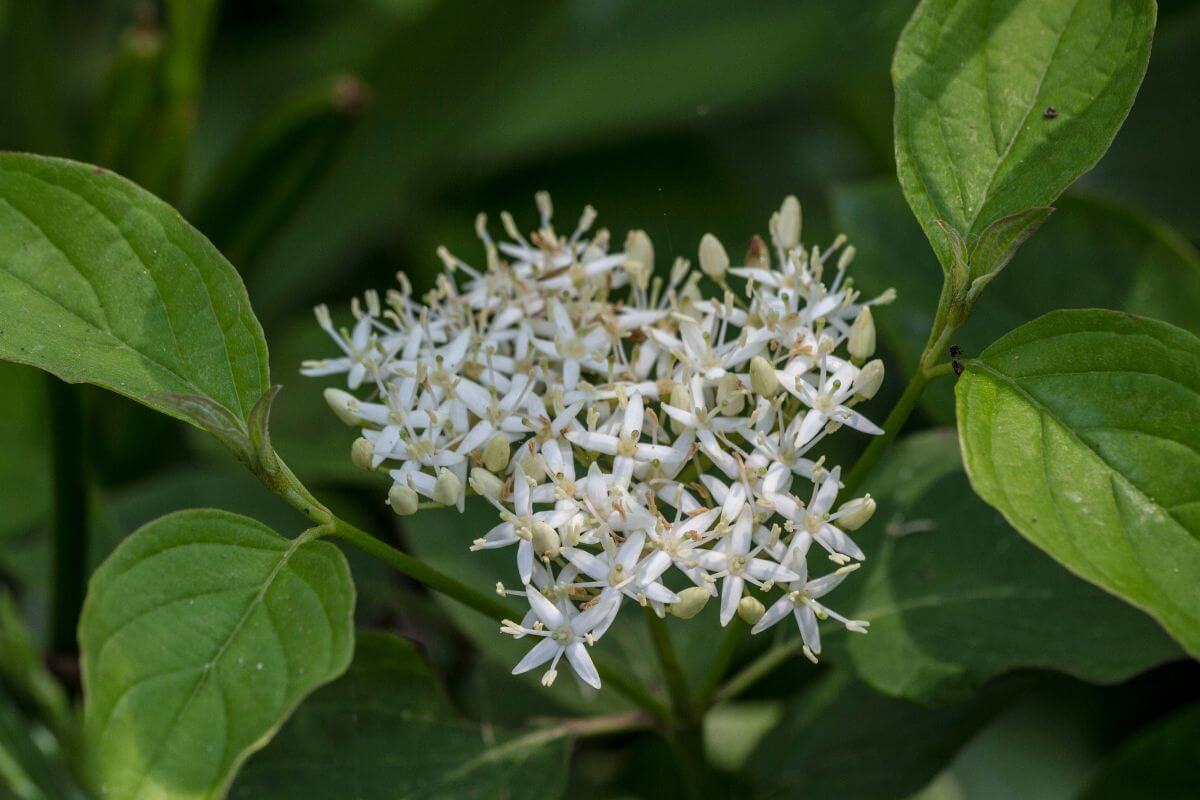
As a native, multi-stemmed shrub found throughout North America, Redosier dogwood, scientifically known as Cornus sericea, is a spectacular addition to any landscape.
Thriving in riparian forests near rivers or streams and wetlands, this plant is no stranger to moisture. But here’s the surprising part – it can also handle partially dry areas. Isn’t nature fascinating?
Growing between 4 to 18 feet tall, Redosier dogwood impresses with its erect yet loosely spreading growth pattern. Redosier dogwood, with its adaptability, can thrive in USDA hardiness zones 2-7, making it suitable for both northern and southern climates.
This attractive shrub is also low-maintenance, flourishing in moist soil and displaying impressive drought tolerance, which is a boon for busy gardeners.
However, it’s important to exercise caution with Redosier dogwood as it contains tannins that can be toxic in large amounts. So, it’s wise to handle it with care and avoid any potential mishaps.
The Redosier dogwood is a breathtaking shrub that adds beauty and versatility to your landscape.
19. Snowberry (Symphoricarpos)
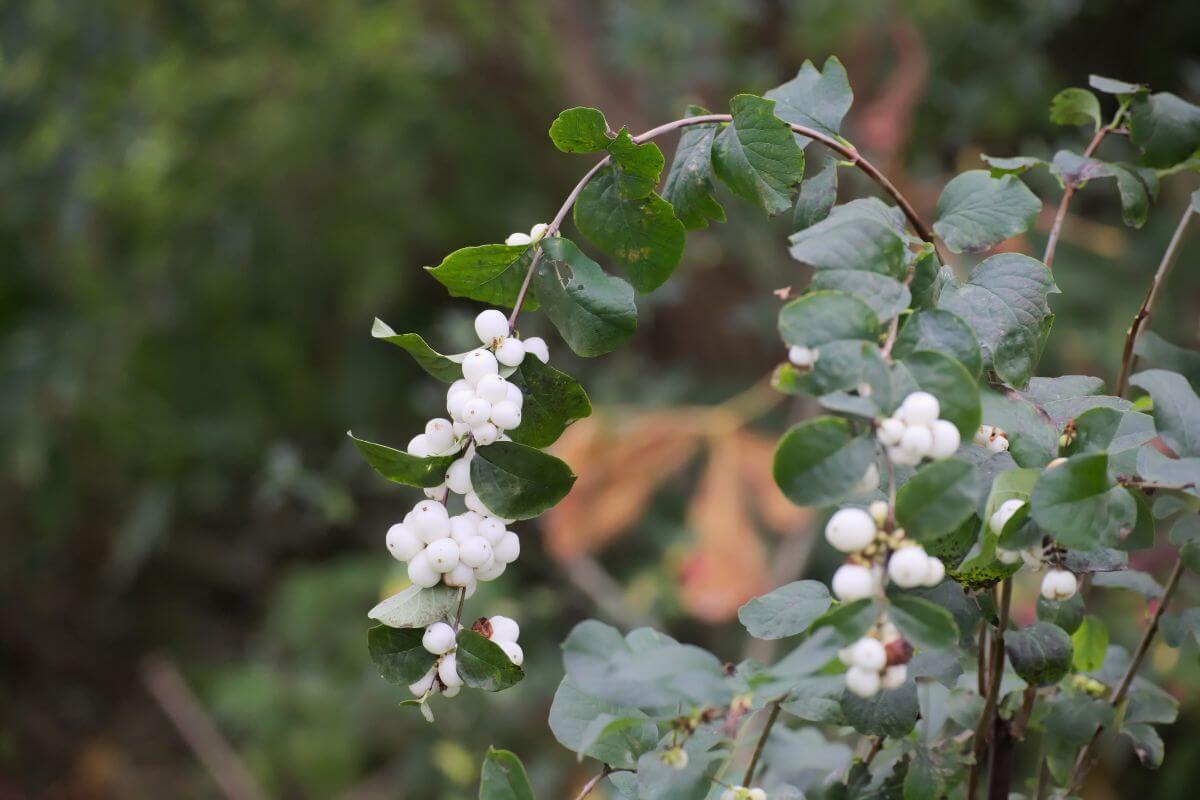
Snowberry, also known as Symphoricarpos, is a small genus of deciduous shrubs in Montana with 3 native species: common snowberry, mountain snowberry, and western snowberry.
Species of the snowberry:
- Common snowberry (Symphoricarpos albus) – This shrub has a bushy, rounded appearance and dull leaves. However, the shrub produces green fruits in late summer that ripen into brilliant white berries in the fall, creating a striking contrast.
- Mountain snowberry (Symphoricarpos oreophilus) – This upright shrub graces the landscape with its pink, trumpet-shaped blossoms in the spring followed by green berries in the summer that ripen to bright white in the fall.
- Western snowberry (Symphoricarpos occidentalis) – This shrub boasts arching branches, gray-green leaves, subtle pink flowers, and white berries.
Standing at a modest height of about 5 feet tall, snowberry shrubs add a touch of elegance to any landscape. But what truly sets them apart is their remarkable adaptability.
They are hardy plants that can grow in USDA hardiness zones 2-8. They prefer partial sun and moist soil, but they have an incredible drought tolerance.
So even in the hottest and driest of summers, they’ll continue to flourish, unperturbed by the lack of water. It’s almost as if they possess some magical power.
These ornamental shrubs are excellent choices for preventing erosion, enhancing naturalized landscapes, and contributing to the effectiveness of rain gardens.
However, it’s important to exercise caution when dealing with snowberry. This plant contains saponins, which can be toxic in large amounts.
20. Woods’ Rose (Rosa woodsii)
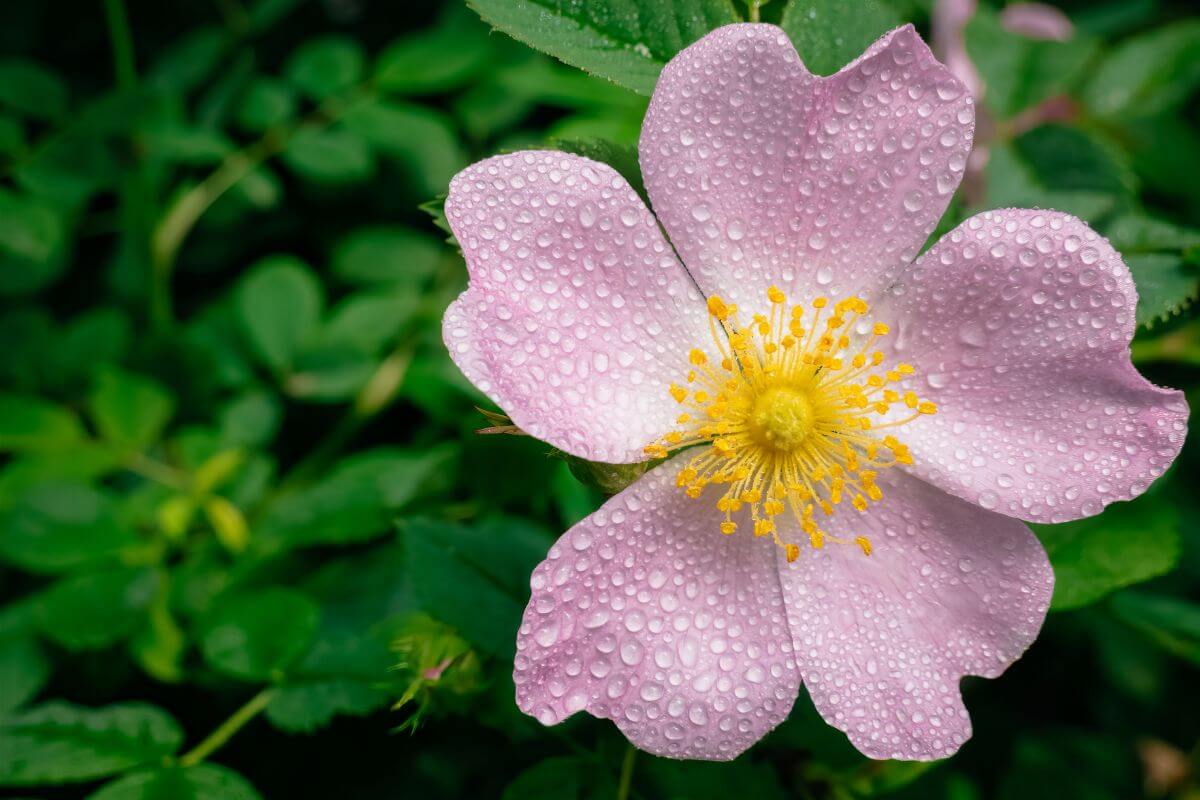
When it comes to native plants in Montana, one cannot overlook the stunning beauty of Woods’ rose, also known as Rosa woodsii.
This small, multi-branched deciduous shrub has found its niche in various habitats across the state, showcasing its adaptability and resilience.
One of the most distinctive features of Woods’ rose is its prickled red stems, which command attention. Combined with its compound leaflets and large, pink, five-petaled flowers adorned with bright yellow stamens, this plant is a true showstopper.
The hips of Woods’ rose are highly valued for their vitamin C content and are often dried for use in teas, jellies, fruitcakes, and puddings.
Not only do humans appreciate these nutritious delights, but many birds and mammals also indulge in them, making Woods’ rose a vital food source in the ecosystem.
In terms of habitat, Woods’ rose can be found in a range of environments. Along streams and other moist habitats, in ponderosa pine forests, and on mountain slopes, it thrives at elevations ranging from 5,500 to 9,000 feet. With its adaptability to USDA hardiness zones 3-8, this hardy plant knows how to make itself at home.
Woods’ rose loves partial sun and moist soil, which allows it to truly shine. But what sets it apart is its remarkable drought tolerance. Even in the face of scorching summers and limited water availability, this resilient shrub continues to flourish, defying the odds.
21. Yellow Columbine (Aquilegia flavescens)
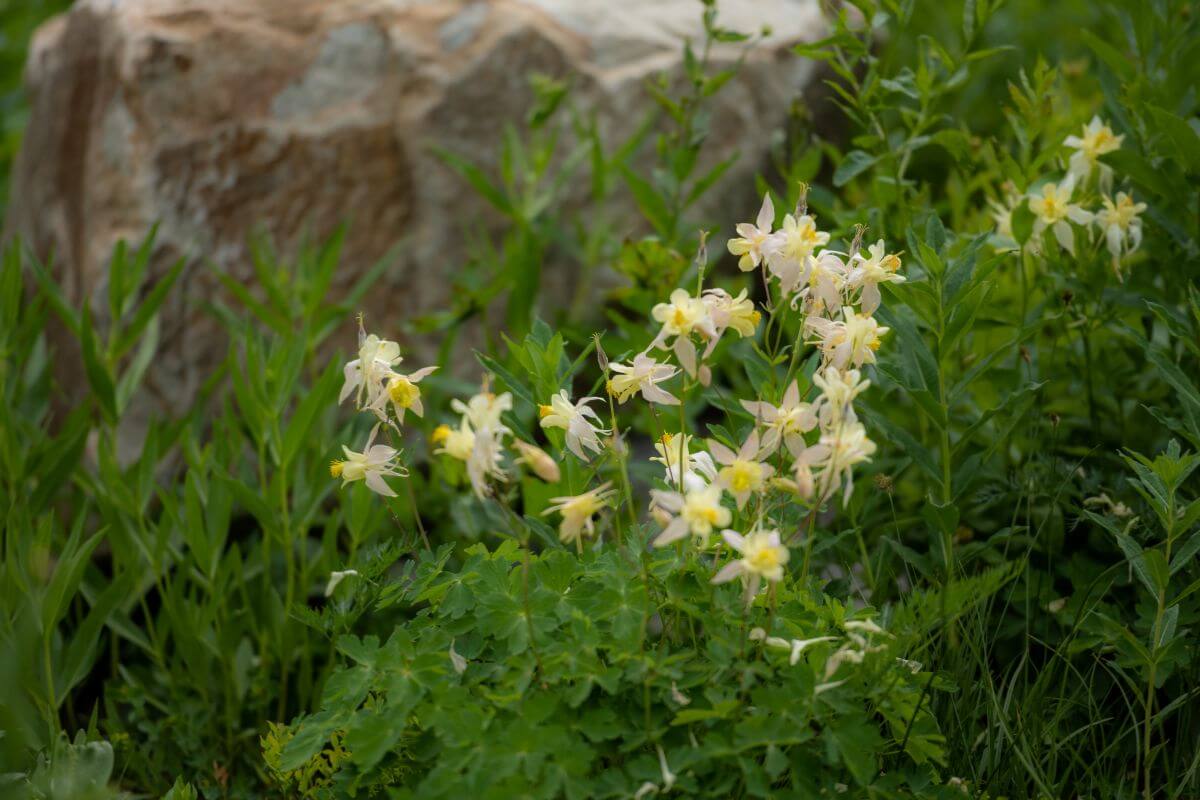
Yellow columbine, also known as Aquilegia flavescens, is a perennial herbaceous flower that belongs to the buttercup family.
Standing at a height of 8-30 inches, this vibrant plant thrives in western Montana’s moist soils, adorning meadows, open forests, stream banks, and rocky slopes. Its tuberous pale peach and yellow flower blooms are a sight to behold, instantly brightening up any landscape.
What sets Yellow columbine apart is its hardiness. It flourishes in USDA hardiness zones 3-8, proving its resilience in various climates. This versatile plant prefers partial sun and moist soil, but its drought tolerance ensures that it can withstand challenging conditions.
But its usefulness goes beyond aesthetics. Its fibrous root system makes it ideal for erosion control, stabilizing the soil, and preventing unwanted shifts.
Moreover, Yellow columbine plays a vital role in supporting wildlife. Birds and small mammals flock to this plant, finding both food and habitat among its beautiful blooms. It has also a rich history in traditional medicine, where it has been used to treat various ailments.
However, it is essential to exercise caution. Yellow columbine contains cardiogenic toxins, which can be harmful in large amounts. While this plant offers unique beauty and benefits, it should be respected and handled with care.
Montana Native Plants Final Thoughts
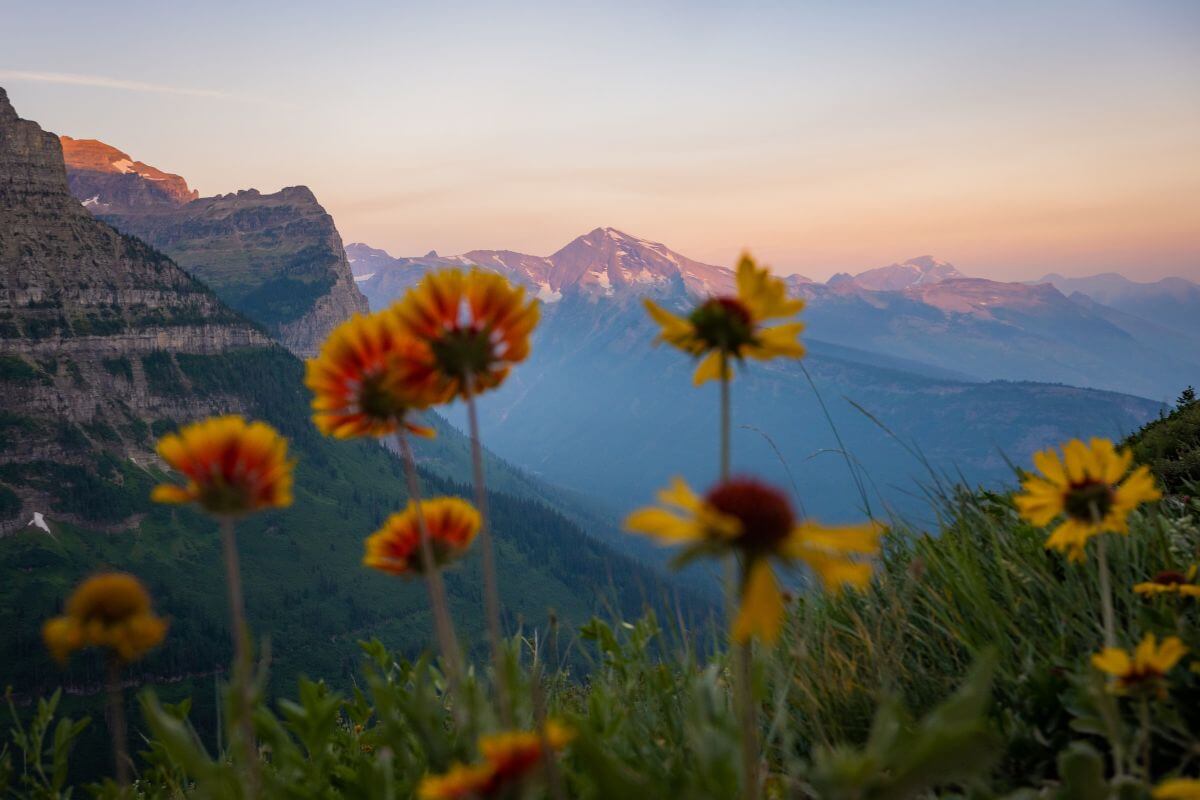
Montana’s native plants are interesting and diverse, thriving in different parts of the state. From the tall Ponderosa Pine to the delicate bitterroot, Montana is a paradise for plant lovers.
For wet soils, the Rocky Mountain iris and Redosier dogwood are great choices. These plants not only look beautiful but also help the environment. In dry areas, the tough Sagebrush thrives with its silver-gray leaves and pleasant scent, making it perfect for any garden.
If you want to add color to your garden, the Blanketflower is ideal. Its bright orange and yellow flowers attract bees and butterflies.
Montana’s native plants are more than just pretty. They support local wildlife and help keep the ecosystem balanced. They provide food and shelter for birds and small animals and have been used in traditional medicine.
Montana Native Plants FAQs
1. How Do You Choose Native Plants for Your Montana Yard?
To choose native plants you first need to match plants with similar site preferences, such as light, soil, and water requirements.
Then test soils for drainage, as most of Montana’s native species will not do well in heavy, poorly drained, or saline soils.
It is very important to choose plants that are well-adapted to the region’s climate and soil conditions to reduce the need for irrigation, fertilizers, and pesticides.
Also, consider using resources from the Montana Native Plant Society, and Center for Native Plants to find native plant material for your gardening and landscaping projects.
2. Where Can I Find Native Plants in Montana?
There are several places to find native plants in Montana, including:
- Center For Native Plants
- Montana Native Plant Society
- Blake Nursery
- Montana Conservation Menu
These organizations provide resources and information on how to grow and care for native plants, as well as where to obtain native plant material for gardening and landscaping projects.
3. What Are the Most Common Plants in Montana?
Montana is home to a diverse range of plant species, including native and non-native plants.
Common plants you can see in Montana include the bitterroot, Ponderosa pine, Rocky Mountain iris, Blue flax, and the Rattlesnake fern.
4. What Is the State Tree of Montana?
The state tree of Montana is the Ponderosa pine (Pinus ponderosa). These evergreen conifers were adopted as the state tree in 1949, and it is a large coniferous pine tree that can grow from 60-130 feet tall.
5. What Flower Is Montana Known For?
The state flower of Montana is the bitterroot (Lewisia rediviva). This native flower was designated as the official state flower in 1895 and is a beautiful purplish-pink flower that blooms in the spring to late summer.
The bitterroot can be found growing in the sagebrush plains and the foothills of the mountains in south-central and western Montana.
Did you love this content? Dive into more great Montana articles:
- Explore Montana’s Thistle Types
- Montana State Butterfly
- Montana’s Fruit Emblem
- Montana’s Emblematic Grass
- https://gaftp.epa.gov/EPADataCommons/ORD/Ecoregions/mt/mt_front_1.pdf
- https://fieldguide.mt.gov/displayES_Detail.aspx?ES=7114
- https://fieldguide.mt.gov/displayES_Detail.aspx?ES=1511
- https://fieldguide.mt.gov/displayES_Detail.aspx?ES=4232
- https://www.fs.usda.gov/wildflowers/plant-of-the-week/lewisia_rediviva.shtml
- https://www.umt.edu/native-garden/visit/gardening.php
- https://www.fs.usda.gov/database/feis/plants/tree/pinponp/all.pdf
- https://ucanr.edu/sites/forestry/Ecology/Identification/Ponderosa_Pine_Pinus_ponderosa/
https://www.fs.usda.gov/wildflowers/plant-of-the-week/achillea_millefolium.shtml - https://plants.ces.ncsu.edu/plants/achillea-millefolium/
- https://www.for.gov.bc.ca/hfd/library/FIA/2009/FSP_Y093329g.pdf
- https://www.fs.usda.gov/database/feis/plants/forb/linlew/all.html
- https://extension.usu.edu/rangeplants/forbs-herbaceous/lewis-flax
- https://plants.ces.ncsu.edu/plants/amelanchier/
- https://www.fs.usda.gov/rm/pubs_int/int_rp218.pdf
- https://www.fs.usda.gov/ccrc/topics/invasive-plants
- https://www.fs.usda.gov/research/news/highlights/invasiveness-and-impact-48-exotic-plant-species-native-grasslands
- https://fieldguide.mt.gov/Invasives.aspx
- https://hort.extension.wisc.edu/articles/blanket-flower-gaillardia-spp/
- https://www.mjc.edu/instruction/agens/native_book_5_edit_10_21_2016.pdf
- https://fieldguide.mt.gov/?elcode=PDSCR1L750
- https://www.fs.usda.gov/database/feis/plants/shrub/shearg/all.html
- https://trees.umn.edu/chokecherry-prunus-virginiana
- https://plantvillage.psu.edu/topics/clover/infos
- https://www.mjc.edu/instruction/agens/native_book_5_edit_10_21_2016.pdf
- https://fieldguide.mt.gov/speciesDetail.aspx?elcode=PDCOR010C0
- https://fieldguide.mt.gov/speciesDetail.aspx?elcode=PDCPR05080
- https://plants.usda.gov/DocumentLibrary/plantguide/pdf/cs_rowo.pdf
- https://www.fs.usda.gov/wildflowers/plant-of-the-week/Aquilegia-flavescens.shtml
- http://home.nps.gov/azru/learn/nature/native-plant-trail-guide-shrubs-and-trees.htm
- https://www.flickr.com/photos/plant_diversity/48665916548

